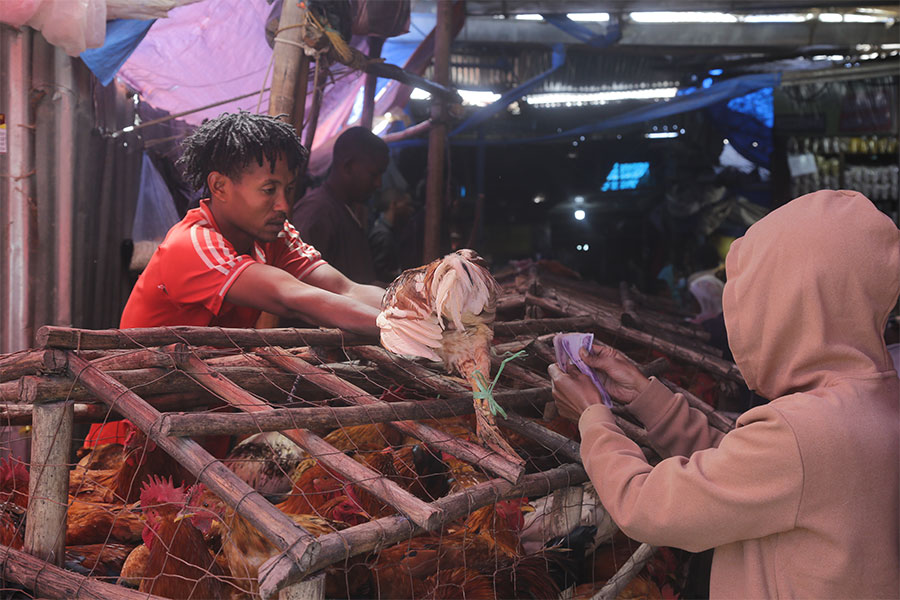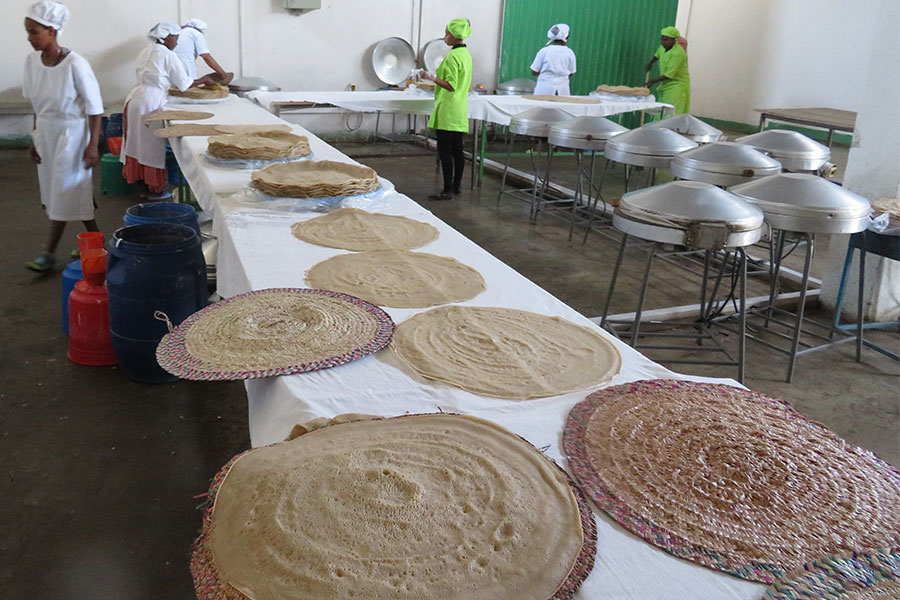
He was a farmer who came to the city looking for international buyers for his crops. The plan was to come to Addis Abeba and sort out an export license and hopefully seal deals with interested buyers. As the head of his cooperative union, Desalegn Legese would also be representing 32,000 other farmers from his hometown, each with small plots of their own. The 40-year-old farmer has been growing sesame since his return home after graduating from Meqelle University in 2004.
Desalegn worked hard to make a living on his plot in Qafta Humera Wereda in West Tigray Zone and eventually was elected general manager of the Setit Humera Cooperative Union, a constellation of 20 primary farmers unions in Setit Kebele within the Wereda. He says his work ethic and modern education played a big role in that.
Qafta Humera is among the major areas of sesame production well known for its high-quality aromatic white Humera sesame. The area produces 100,000ql to 150,000ql of sesame a year with Setit, where Desalegn resides, generating up to 40,000ql of the lot. The farmers in Setit also grow sorghum, but the white Humera sesame is especially suitable for baking and has high demand in the market. It was with a plan to start exporting their sesame and get an even better value for it that Desalegn came to Addis Abeba.
“It was a Saturday when I left," he said. "I left thinking that I would be back home soon. I didn't prepare for anything."
He arrived in Addis Abeba on a Saturday, and things started well. Talks with potential sesame buyers were bearing fruit, and he was making headway at getting the necessary grants for export at various public institutions. In fact, Desalegn had already talked to and signed contracts with potential buyers when all hell broke loose.
At midnight on Tuesday, November 4, Desalegn and the rest of the country woke up to the news of armed conflict that had broken out between the federal government and the Tigray regional administration, one of the 10 regions in the country and where Desalegn was born and raised. Communications were promptly shut off following what the government dubbed a law enforcement operation against the region's leaders. Borders were militarised.
“I don’t know what is going on there,” he said.
He hasn't been able to communicate with anyone for over two weeks. It is harvest season back home, and he is concerned about the fate of his crops and many others like him.
“Sesame isn't like other crops. It's susceptible and easily damaged,” explained Desalegn.
He spoke of his fear of fire damage to the crops as well, especially since the area around the farms are covered with dry grass.
“If we don't sell our crops on time, we lose it to pests when we don't have sufficient chemicals," he said.
The option of storage, if one, is also not ideal for sesame crops. The seed loses moisture and, consequently, weight if it is stored in warehouses for long periods of time. In the past, farmers would store sesame in the hope of selling it for a higher price when the market supply ran low and demand shot up.
Qafta Humera is among the major areas of sesame production well known for its high-quality aromatic white Humera sesame.
Now, however, there is no significant price variation across seasons and storing sesame in warehouses is not beneficial to the farmers, according to Desalegn.
“If you store a quintal of sesame for two months," he said, "it will lose five to 10 kilograms. It has to be sold immediately."
At the time of his departure for the capital, the farmers in Humera had already started collecting sesame to later supply to buyers.
Setit Cooperative Union has come a long way since its establishment in 2004. It had endured difficult circumstances and was starting to recuperate when the conflict began, according to Desalegn. The Union began small and then started offering market facilitation services to members by availing their produce to buyers through the Ethiopian Commodity Exchange (ECX). This enabled the farmers to export the sesame that they grew on their land.
The Union would either sell the sesame directly or for commission prices. At times, it would buy the product from its primary unions and present them for export itself or aid the farmers as a middleman. When acting as a middleman, Setit charges commission from the income in return.
As the Cooperative Union paid 50 Br or more above the market price a quintal, the primary unions who supply sesame preferred to sell or supply their products to Setit, according to Desalegn.
However, since 2014, Setit has been operating with heavy losses on its sesame export operations. The price of sesame in the domestic market was constantly increasing, while the product was being sold at lower prices in the international market. Exporters were buying the sesame for 5,000 Br a quintal and selling it for 4,000 Br in the international market.
Many sesame traders had been scrambling for the limited supply by offering higher prices, thereby driving up the local market price.
Although Setit earned 850,000 dollars from the export of sesame products in 2014, it was forced to cease all sesame export operations that year due to market price inflation issues.
Despite this, many in the sector have chosen to remain in the sesame export business. In fact, merchants were exporting sesame at a loss due to the limited availability of hard foreign currency in the country.
“Even though they operate with losses, it has still been essential [to export] for many traders, because they import commodities using the foreign currency generated from sesame exports,” said Desalegn.
In October 2019, the Ministry of Trade & Industry issued the Export Contract Registration & Performance Directive to avoid under-invoicing of agricultural goods in the international market by setting price caps. This enabled traders and exporters to get sesame products at lower prices than they had been previously. A quintal of sesame that was being sold for between 5,000 Br to 6,000 Br before the law was issued has since been lowered to 3,500 Br on average this year.
Following the regulatory measures taken by the Ministry, the Union has been undergoing preparations to resume sesame export activities.
The instability, however, has disrupted the sesame trade in the area, and traders and exporters are no longer being supplied with the white Humera sesame. Private exporters are also facing challenges due to the situation in Tigray. Sesame is no longer brought from Humera.
Tekhaf Trading Plc, a company engaged in the export of sesame and soybeans, used to buy sesame mainly from Humera. Last year, the company exported 600ql of sesame, and 70pc of it was supplied from Humera. Tekhaf is now turning to other areas to look for sesame products for export, according to Anteneh Zewdie, general manager at the firm.
“We're also focusing on other pulse crops for export,” said Anteneh.
The instability comes in parallel to limited global sesame production this year. China and India, major sesame producers, have lower outputs due to heavy rainfall, according to the general manager.
“Therefore, higher demand and higher prices for sesame are trending in the international market," he said. "Unfortunately, we don’t have much production.”
Another exporter, a namesake of Desalegn's hometown, Setit Trading Plc, is among the major sesame buyers in the area and owns a warehouse for storing sesame.
“We'd been preparing to export if not for the situation,” said Kidane Mariam G. Tsadik, co-owner and general manager of the company. It has been unable to load the sesame that is being stored in its Humera warehouse, according to the co-owner.
The conflict has not only cast a shadow over the market in west Tigray but also over sesame production and sesame agriculture across the nation.
Farmers in Genda Wuha, located 40Km east of Metemma, have noticed a sesame market disruption in the area. Many are rushing to sell their sesame due to security concerns, according to Zeleke Mamo, a farmer who also serves as general manager of the Metemma Farmers Cooperative Union.
During previous busy seasons, there used to be 30 to 40 trucks loading sesame in the area, but now, unusually, one can see up to 70 trucks a day.
"There is heavy congestion,” said Zeleke.
Besides this, many farmers are also halting sesame production and growing sorghum instead. This could be hard for the sesame export business sector and the country in terms of foreign currency, according to Geremew Terefe (PhD), manager at the Sesame Business Network.
The country’s sesame production and revenues from its export is in an alarming decline. Just last year, Ethiopia received an export receipt of 347 million dollars after exporting 215,190tn, representing half the volume it had five years ago.
The numbers for the first quarter of this year are worrying. Shipping off close to 19,000tn, exporters have generated a mere 27 million dollars, signaling that the prospect for the whole year may not be pleasant.
In the kebelewhere Desalegn lives, 80pc of the land is covered with sorghum this year. Similarly, the 222,000ha of land that was covered by sesame in Genda Wuha Kebele last year has decreased to 145,000ha.
This has to do with the decline in the price for sesame last year, particularly in March and April, according to Geremew.
"Many new edible oil plants that use other oilseeds will turn to sesame if the decline in price continues," he said. He explained that due to the high prices of sesame, edible oil factories have instead been utilising noug, soybean, cottonseed, sunflower seed and others.
The magnitude of the effect of the instability in the area could be massive as the West and Northwest zones of Tigray Regional State are the source of 35pc to 40pc of the country’s total sesame production, according to Geremew. Combined, the Amhara and Tigray regional states produce about 75pc of Ethiopia’s annual output.
Geremew urges farmers to use bags that guard against pests and desiccation to protect their products.
This season is crucial to sesame production, and the conflict may affect the farmers and people involved in the value chain, says the expert.
"Banks and cooperative unions should work together in availing revolving funds to farmers," he said. "Many sesame farmers have challenges regarding access to finance since they're asked for collateral."
Desalegn believes the decline in sesame production is because people pay more for sorghum nowadays. Sorghum also has higher productivity. A hectare of sorghum can yield 25ql to 30ql, but a hectare of sesame yields less than two quintals.
“The cost of production of sesame is also far higher than sorghum,” he added.
Even so, this is far from what occupies Desalegn's mind these days.
PUBLISHED ON
Nov 21,2020 [ VOL
21 , NO
1073]

Radar | Apr 13,2019

Commentaries | Jun 18,2022

Fortune News | Aug 11,2024

Agenda | Jan 07,2023

Addis Fortune Press Release | Oct 04,2024

Featured | Mar 07,2020

Films Review | Jan 23,2021

Radar | Jul 13,2024

Agenda | Sep 14,2024

Featured | Jan 07,2024

Dec 22 , 2024 . By TIZITA SHEWAFERAW
Charged with transforming colossal state-owned enterprises into modern and competitiv...

Aug 18 , 2024 . By AKSAH ITALO
Although predictable Yonas Zerihun's job in the ride-hailing service is not immune to...

Jul 28 , 2024 . By TIZITA SHEWAFERAW
Unhabitual, perhaps too many, Samuel Gebreyohannes, 38, used to occasionally enjoy a couple of beers at breakfast. However, he recently swit...

Jul 13 , 2024 . By AKSAH ITALO
Investors who rely on tractors, trucks, and field vehicles for commuting, transporting commodities, and f...

Oct 25 , 2025
The regulatory machinery is on overdrive. In only two years, no fewer than 35 new pro...

Oct 18 , 2025
The political establishment, notably the ruling party and its top brass, has become p...

Oct 11 , 2025
Ladislas Farago, a roving Associated Press (AP) correspondent, arrived in Ethiopia in...

Oct 4 , 2025
Eyob Tekalegn (PhD) had been in the Governor's chair for only weeks when, on Septembe...